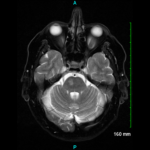George Bruyn, MD, PhD,
honorary consultant rheumatologist,
Medisch Centrum,
Leeuwarden, The Netherlands
I would treat this woman’s GCA with 1 gm of solumedrol qd for three days. She has a significant segmental vasculitic process that is not suppressed. Older patients frequently don’t complain. Perhaps an ESR or C-reactive protein elevated significantly would make everyone feel better about steroid use. There is a good likelihood that the surgeon’s fancy surgery will fall apart because of active vasculitis in the suture line if left untreated.
Andrew Daugavietis, MD,
Arthritis Clinic,
Grand Rapids, Mich.
I may have at least a partial answer for you. Please check our article, “Occult active giant cell aortitis necessitating surgical repair” (J Thorac Cardiovasc Surg. 2000;120:813-815).
In essence, we looked at all surgical specimens at Mt. Sinai requiring surgery for aortic aneurysms. Pathological studies showed that about 2% had giant cell arteritis. This had not been acted upon by the physicians taking care of the patients and—to our knowledge—none were treated with corticosteroids. From perusal of the charts there were no symptoms suggestive of GCA. Dr. Kerr followed five of the 12 patients, and only one apparently developed polymyalgia rheumatica. None had any vision loss.
When we diagnose GCA we are seeing only the tip of the iceberg. In a study done many years ago in Malmo (where every person who died has had an autopsy), when sections of the aorta and temporal arteries were studied about 2% had histological evidence of arteritis (not necessarily GCA). Interestingly, that matches the 2% incidence of aortitis that we found, in “Temporal arteritis in a large necropsy series” (Ann Rheum Dis. 1971:30 224-235). I suspect that the frequency of vision loss in GCA is less than is commonly believed. Obviously, we need better data as to the natural history of GCA.
Harry Spiera, MD,
clinical professor of medicine/rheumatology,
Mt. Sinai Medical Center,
New York
Dilemmas test our ability to understand principles. The principle being tested in your clinical scenario is that reality trumps probability. Steroids should not be given to this patient in the post-operative period and every effort should be made to help the patient—first and foremost—recover from surgery.
A compromise might be to start imuran, but a significant unknown already identified is whether the aortic GCA may have been remedied by surgical excision. Therefore, observation would be the best approach, especially because none of the telltale signs and symptoms of GCA were present before the surgery. The reality of needing to heal from surgery trumps the probability of all the other scenarios for which steroids are being recommended.

